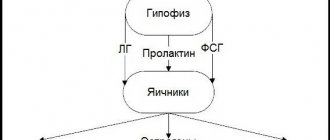Menstrual cycle disorders (MCI) are not a pathology, but only a symptom of problems in the female body. The cause of the failure can be not only diseases, but, in any case, it indicates the presence of a problem that needs to be solved. Therefore, if your menstrual cycle is irregular, you should consult a gynecologist.
General information
At some point in her life, cycle disturbances probably occurred in every woman. Irregular periods , which many women are accustomed to considering as something ordinary, are actually a signal of problems with women's health.
What is NMC in gynecology? This is a disrupted menstrual cycle that happens to women at different periods of their lives.
Irregular menstruation - delays or a shorter cycle, indicate disturbances in the physical or mental state of the woman. The monthly cycle is a kind of biological clock of the body. A disruption in their rhythm should alert you and cause you to consult a doctor so that diseases can be identified in a timely manner. Below we will talk about why the menstrual cycle fails and what a woman should do in such a situation.
Causes of dysfunction
Any changes in the clinical picture in the course of menstruation do not in themselves indicate the presence of the disease, but are a signal of possible hormonal changes in the woman’s body. The reasons affecting hormonal levels are varied.
Pregnancy
Monthly bleeding in a healthy woman indicates that the mature egg remains unfertilized and pregnancy has not occurred. The place on the inner wall of the uterus, prepared for the attachment and subsequent development of the fetus, becomes unnecessary and the tissue (endometrium) begins to peel off. Pieces of the endometrium come out along with blood and mucus.
Disruption of the menstrual cycle can occur due to conception. The female body begins to produce an increased amount of hormones, which causes the cessation of menstruation. After fertilization, the egg is attached to the endometrial tissue for subsequent development.
All functions of the uterus are aimed at preserving the fetus until full maturity. After pregnancy occurs, menstruation stops completely. The exception is spotting in the first month of pregnancy.
This phenomenon is observed if conception occurs at the end of the cycle. During all subsequent periods, a pregnant woman does not have menstruation. The absence of menstruation in a pregnant woman is considered normal. Any changes in the nature of the discharge require consultation with a gynecologist.
Stress
Menstruation is one of the most important indicators of a woman’s health. In stressful situations, a sharp release of the stress hormone cortisol occurs in the body. Excess cortisol affects the production of estrogen and progesterone. As a result of changes in the amount of sex hormones in the female body, the menstrual cycle is disrupted.
The consequence of the violation is a deterioration in health, a change in the duration and abundance of discharge.
Acclimatization
The process of adaptation of the body to new climatic conditions in women is much more acute than in men. The functioning of all body systems is influenced by environmental factors, and their changes affect the state of health.
- Changes in atmospheric pressure (flights).
- Changing time zones.
- An increase or sharp decrease in air temperature.
- Air humidity.
- Changes in background radiation.
Stressful elements cause a weakening of the immune system, exacerbation of chronic diseases is observed more often than in a usual environment. A delay or prolonged absence of menstruation is a sign that the girl is in a state of acclimatization.
This is a reversible process that is restored as soon as the body adapts to unusual changes. A deficiency of hormones produced by the body during the acclimatization period leads to scanty and erratic discharge (unstable periods).
Changing your way of life
Disorders of the menstrual cycle, the causes of which are changes in the usual lifestyle, can affect the general condition of the entire body. With an incorrect lifestyle, not only the reproductive system suffers, but also brain activity, digestive and cardiovascular systems.
- A common cause of delayed menstruation is general intoxication of the body , which occurs when drinking large amounts of alcohol and smoking. Bad habits have a destructive effect on all human systems and organs and are irreversible. The disruption of the menstrual cycle caused by acclimatization normalizes on its own after the body gets used to new living conditions. The liver, heart and kidneys, which are gradually destroyed under the influence of alcohol, are not able to recover on their own. The female body evaluates the general state of health as an undesirable moment for conception and preservation of the fetus. The production of hormones responsible for the maturation of the egg decreases and the menstrual cycle fails.
- Drug addiction and the use of various psychotropic substances that depress nervous and brain activity affect a woman’s mental state (excitability, mood swings, depression) and affect reproductive function.
- The harmful chemical industry is a threat to the health of a pregnant woman and her unborn baby. Women who work in hazardous work for a long time often suffer from an unstable menstrual cycle.
- Excessive physical activity negatively affects a woman’s health. Do not confuse healthy physical education with the daily hard training of professional athletes. Women who have devoted their entire lives to sports often face the problem of childbearing.
Weight gain or sudden weight loss
Cyclic changes in the female body indicate the state of health of the whole organism. When everything is within normal limits, menstruation occurs without deviations, exactly on time. As soon as a malfunction of any organ occurs, changes in the functioning of the reproductive system are observed.
Excess weight can cause gynecological problems. Adipose tissue contains a large number of fat cells. In these cells, a complex mechanism occurs for the conversion of female sex hormones from the male hormone - testosterone. Testosterone levels in obese people are 3 times higher than normal.
The body is not able to convert such a large number of male hormones in a timely manner, which leads to an incorrect ratio of the amounts of male and female hormones. Excess testosterone in a girl leads to menstrual irregularities, increased body hair growth, and infertility.
Menstrual irregularities can occur due to sudden weight loss or weight gain.
A large amount of estrogen in obesity leads to the proliferation of endometrial tissue and its incomplete rejection after menstruation. Remains of the mucous membrane accumulate in the uterus and become denser, which leads to the development of hyperplasia (precancerous condition). The risk of developing uterine cancer in obese women is 10 times greater than in women whose weight is within the normal range.
The fight against extra pounds should be carried out under the supervision of a nutritionist and endocrinologist. Sudden weight loss leads to metabolic and hormonal imbalance. With improper weight loss, the uterus and ovaries decrease in size, which leads to the development of hypomenorrhea.
Stopping menstruation for a long time can lead to infertility. If there has been a disorderly struggle with excess weight and sudden weight loss has led to disruption or cessation of the menstrual cycle, you should immediately consult a doctor. You need to lose weight gradually, giving the body the opportunity to adapt to physiological changes.
Infectious and colds
Disruption of the menstrual cycle, the causes of which are often associated with previous colds and infectious diseases, is not long-term and recovers quickly. The immune system weakens after fighting a viral infection and a missed period may occur. The cycle is completely restored after 1 or 2 months without additional treatment.
If during this time the cycle does not normalize, you should consult a doctor.
Hormonal disorders
The main organ responsible for the production of hormones is the thyroid gland. A woman's reproductive system is a balanced, well-functioning mechanism. Any imbalance causes delay in menstruation. The delay is the initial signal of problems in the body.
Often, disruptions in a woman’s cycle indicate a hormonal imbalance. Diseases of the thyroid gland primarily affect the functioning of the reproductive system in a woman’s body. Insufficient activity of the thyroid gland causes ovarian dysfunction, preventing the formation of the corpus luteum and the development of the egg.
- Hypomenorrhea may occur - a significant decrease in the total volume of menstrual flow.
- Some patients complain of oligomenorrhea - a reduction in menstruation to 1 day.
- Opsomenorea - the time interval between menstruation increases to 9 weeks.
- Spaniomenorea – menstruation occurs 2 to 5 times a year.
- In rare cases, increased bleeding occurs.
Most often, in advanced cases, amenorrhea develops. This is the complete cessation of menstruation. If you do not seek medical help in a timely manner and do not begin restoring hormonal balance at the first signs of thyroid dysfunction, the consequences will be irreversible.
Menstrual irregularities, the causes of which lie in hormonal imbalances, can only be treated with hormonal agents. A woman needs to remember that the monthly cycle is a sensor indicating the health status of the entire body. Good results are observed with treatment with thyroid hormones.
Taking medications
A common cause of an unstable menstrual cycle is taking medications of various spectrums of action. The nature of the discharge and its duration vary depending on the purpose of the drug.
- Substances that thin the blood and reduce the risk of blood clots affect the intensity of bleeding. The discharge becomes more abundant and the duration of menstruation increases.
- Properly selected oral contraceptives stabilize the menstrual cycle. Long-term use of birth control pills leads to a reduction in the duration and abundance of discharge.
- While taking antidepressants, there may be a delay, and the discharge may appear more scanty.
- Hemostatic drugs are sometimes prescribed for heavy bleeding. Their use reduces the amount of discharge.
- Antiulcer medications may affect cycle stability.
- The delay or early onset of menstruation may be affected by antibiotic treatment. Similar symptoms are most often observed in women with an initially unstable cycle.
Gynecological diseases
The reasons for the instability of the reproductive organs often lie in the presence of gynecological diseases in a woman. Inflammatory processes occurring in the pelvic organs become the likely culprits of an unstable monthly cycle.
- Too heavy periods (hypermenorrhea) may indicate the presence of endometrial hyperplasia, uterine fibroids, and inflammatory processes in the genitals.
- A change in the nature and course of menstruation occurs when infected with infectious diseases. Chlamydia, candidiasis, gonorrhea and many other similar diseases most often enter the body through the genital tract. The course of the disease may not manifest itself in any way, which complicates the treatment process. By regularly taking a smear for microscopic examination, you can prevent the spread of infection in time and begin treatment.
- The endocrine system is a well-functioning mechanism for the production of hormones. The adrenal glands, ovaries and thyroid gland produce hormones responsible for the maturation of the egg and the development of the embryo. If one of the organs of the endocrine system malfunctions, the reproductive activity of the body is disrupted and the first signal of an impending problem is a delay and change in the nature of menstruation.
- Neoplasms of various types located in the uterine cavity, cervix or ovaries without timely diagnosis lead not only to infertility, but also to cancerous lesions of internal organs.
Every woman can determine the presence of gynecological diseases by changes in the nature of menstruation , the duration and abundance of discharge; unexpected bleeding occurs in the middle of the cycle, sharp pain in the abdomen or lower back.
Childbirth or abortion
Dysfunctions of the menstrual cycle are observed in women after childbirth or abortion. After the birth of a child, the female body begins to actively produce the hormone prolactin, which regulates the quantity and quality of breast milk.
Prolactin inhibits the formation of hormones responsible for the formation of the follicle and preparation of the woman’s reproductive system for pregnancy and gestation, so menstruation does not begin in the first months after childbirth. The process of resumption of menstruation after childbirth directly depends on the duration of breastfeeding.
The sooner milk production stops, the faster the menstrual cycle will resume. Too early menstruation (less than 2 months after the birth of the baby) may indicate gynecological abnormalities and requires consultation with a doctor.
Termination of pregnancy by surgical or medical method is an intervention in the well-functioning functioning of the body. The abortion procedure is aimed at removing a fertilized egg from the uterine cavity.
Drug intervention stops the production of progesterone and entails rejection of the fertilized egg along with endometrial tissue; surgical intervention involves mechanical removal of the embryo. Restoration of the hormonal process should occur under the supervision of a physician.
The moment of termination of pregnancy is considered to be the first day of the menstrual cycle. If your cycle was 27 days before the abortion, your first period should begin 27 days after the procedure. Stabilization of the cycle is restored from 2 to 7 months. The reason to consult a doctor is the absence of menstruation for more than 2 months after an abortion.
What is the menstrual cycle
It is important to clearly know what the menstrual cycle is in women and what normal menstrual function should be.
Menarche , that is, the first menstruation, occurs in girls between 12 and 14 years of age. At what age girls start menstruating depends on where they live. The further south a teenager lives, the earlier menarche occurs. It is important for parents to monitor when girls begin menstruation in order to understand whether the body is developing normally.
Between the ages of 45 and 55, the menstrual period ends. This period is usually called premenopausal.
During menstruation, the functional layer of the uterine mucosa is rejected as a consequence of a decrease in progesterone in the body. A woman's monthly cycle is divided into three phases.
- Phase 1 , follicular, is characterized by the production of estrogens , under the influence of which follicles . From all the follicles, a dominant follicle is subsequently released, from which a mature egg is later released.
- Phase 2 of the menstrual cycle is the shortest phase, lasting approximately 1 day. At this time, the follicle ruptures and the egg is released from it. It is important to understand, when talking about what distinguishes the second phase of the menstrual cycle, that this is the time when the egg is ready for fertilization. This is the fertile phase when conception can occur.
- Phase 3 , luteal - the period when the synthesis of progesterone by the corpus luteum, which arose at the site of the ruptured follicle, begins. Progesterone prepares the endometrium for subsequent implantation of a fertilized egg. But if conception never occurs, the corpus luteum gradually dies, progesterone production decreases, and the endometrium is gradually rejected, that is, menstruation begins.
If progesterone deficiency is noted, estrogen production is activated again, and the cycle repeats again. For ease of perception, a diagram of the phases by day is useful, where all the phases of the cycle are indicated and what these phases are called.
Thus, the menstrual cycle is a cyclical change that occurs over a certain period of time. The duration of a normal cycle should be from 21 to 35 days. If there is a deviation in a certain direction for 3-5 days, this cannot be considered a pathology. However, if more significant changes are noted, then the woman should be wary of why the menstrual cycle is shortening or becoming longer.
If a woman has a normal menstrual cycle, how many days her period lasts is a purely individual indicator. The normal duration of menstruation is from three to seven days. It is important to take into account, paying attention to the duration, that this condition should not be a very difficult period for a woman. After all, an important characteristic is not only the normal duration, but also the fact that menstruation should not cause very strong discomfort. During this period, about 100-140 ml of blood is lost. If there is heavy blood loss or the woman notices that the retention rate is violated, it is important to immediately contact a gynecologist.
The cycle is regulated at 5 levels.
| The first level is the cerebral cortex | If your menstrual cycle is out of whack, the reasons may be related to emotions, stress, and worries. |
| Second level - hypothalamus | It contains a synthesis of releasing factors affecting the third level. |
| Third level - pituitary gland | Produces follicle-stimulating and luteinizing hormones or gonadotropic hormones that affect the fourth level. |
| Level four – ovaries | Under the influence of pituitary hormones, depending on the phase of the cycle, the synthesis of estrogen or progesterone occurs. |
| Fifth level – female genital organs | Changes in the endometrium occur in the uterus, the epithelium in the vagina is renewed, peristalsis is noted in the fallopian tubes, which facilitates the meeting of sperm and egg. |
Why is the monthly cycle accompanied by bleeding?
The menstrual cycle consists of several phases and ends with menstruation or otherwise menstrual bleeding.
Physiologically, a woman’s reproductive system goes through 3 stages of the cycle during the month:
- During the first follicular stage, the body produces the hormone “estrogen,” which helps the follicles mature. And later, inside the largest follicle, which is called dominant, the egg matures.
- During the ovulatory stage, an egg is released from the dominant follicle over several days. She is already fully matured and ready to meet sperm and fertilization.
- During the third luteal stage in the female body, the corpus luteum synthesizes the hormone progesterone, which prepares the endometrium for the “implantation” of a fertilized egg into it. If fertilization has occurred and the egg has successfully attached to the walls of the endometrium, then the woman can observe a few drops of blood. This process is called "implantation bleeding." And if conception and implantation do not take place, the corpus luteum is gradually destroyed, the level of progesterone decreases sharply and the process of cleansing the endometrium begins. This is menstrual bleeding.
Bleeding comes from a wound that forms at the site where endometrial tissue is torn from the wall of the uterus. During menstruation, endometrial particles come out with blood. Blood and mucous clots may also come out, causing the woman to feel tolerable pain. This is fine. Menstrual bleeding includes not only the layers of the endometrium, but also particles of an unfertilized egg, blood from damaged vessels and the mucous membranes of the endometrial walls.
Causes of menstrual irregularities
In fact, the causes of irregular menstruation are very diverse and there are many of them. Conventionally, the causes of menstrual irregularities can be divided into three groups:
- The first is external factors that affect the normal cycle. That is, etiological factors influence the cerebral cortex. A woman may note that the cycle has decreased or, conversely, it is longer, if she has suddenly changed the climate, was in a state of prolonged stress, “sat down” on a strict diet, etc.
- The second is a consequence of pathological conditions affecting not only the reproductive system, but also the body as a whole. Thus, the reasons for the disruption of the menstrual cycle after 40 years are often associated with the onset of menopause. However, it is possible that the reasons for the failure of the menstrual cycle after 40 years are due to the presence of health problems in a middle-aged woman.
- The third is the influence of medications. Often the answer to the question of why the menstrual cycle fails is treatment with a number of drugs. A delay or other failure is possible both after starting certain medications and after stopping them. We are talking about hormonal contraceptives, anticoagulants, antiplatelet agents, glucocorticoids, etc.
Popular questions
My periods are irregular.
What to do in this case? It is necessary to make an appointment with an obstetrician-gynecologist. Conduct an examination to determine the cause of ovarian-menstrual irregularities. Therapy will eliminate unfavorable factors and restore the regularity of the cycle.
The cycle is not standardized. This time it was 35 days. Let's go, as I thought, brown periods. And it anointed for two days and stopped. There is no pain, discomfort, or unpleasant odor. The breasts did not hurt before menstruation, although they usually swell and ache. With the beginning of this menstruation I started drinking OK. Why is there no normal menstruation?
I recommend excluding possible pregnancy. If the test is negative, then you should continue taking the contraceptive. When starting to use CHCs, there may be a reduction in the volume of menstrual flow.
Hello! My cycle lasts 27 days, for six months, previously it was 30, and there were no failures, on the 11th-12th day my breasts swelled and hurt, and during this period she only got sick on the 24th day of the cycle, what could it be? Could there be some kind of failure and what could this be connected with?! Who to contact!? And yet, now it’s already the 30th day, maybe we’ll get back to the 30-day cycle...
Hello! An interval of 21-36 days for the menstrual cycle is considered normal. Fluctuations can be associated with various external and internal factors: changes in climate zones, diseases, physical activity, etc. The normal occurrence of mastodenia is that there should be no pain in the mammary glands. Therefore, you can make an appointment with an obstetrician-gynecologist and mammologist to exclude the development of possible diseases. At this stage, I recommend starting to take the product - Gynocomfort Evening Primrose Oil. This will help stabilize the cycle and eliminate pain and engorgement in the mammary glands. The product is taken 2 capsules 2 times a day for 3 months.
Hello. I have 51 days of my cycle. On days 38, 39 and 40 there was pale pink discharge, similar to menstruation, my back hurt and my stomach was tight (not as painful as usual). Can this be considered menstruation? The tests are negative. The last one was done on the 50th day of the cycle. I took Duphaston for 5 days, in the hope that normal periods would come. But there is nothing. Stretches the lower back and lower abdomen. My chest hurts from time to time.
Hello!
If the menstrual cycle is irregular, before taking hormonal medications, you should undergo an examination - Ultrasound of the pelvic organs. This helps to assess changes in the ovaries and endometrium, clarify in which phase the failure occurred and correctly prescribe cycle correction. For an accurate diagnosis, contact a specialist
Factors associated with pathological conditions
- Ovarian pathologies - we are talking about disruption of the connection between the ovaries and the pituitary gland , ovarian cancer, drug stimulation of ovulation, failure of the second phase of the cycle. Also, irregular periods associated with ovarian pathology can be a consequence of negative occupational exposures, radiation, vibration, and chemical influences. The reasons for an irregular menstrual cycle may be associated with surgical interventions performed on the ovaries, injuries to the genitourinary organs, etc.
- Disturbed interaction between the hypothalamus and pituitary gland - an irregular cycle may be associated with too active or insufficient release of gonadotropic hormones and releasing factors. Cycle disturbances are sometimes the result of a tumor of the pituitary gland or brain, hemorrhage in the pituitary gland, or necrosis.
- Endometriosis - if a woman develops endometriosis, both genital and extragenital, the hormonal nature of this disease leads to an imbalance of hormones.
- Violation of the blood clotting process - hemophilia , other genetic pathologies.
- Curettage of the uterus - the endometrium is damaged if curettage is performed after termination of pregnancy or for the purpose of treatment. As a result, complications may develop - inflammatory processes of the uterus and appendages. Irregular periods after childbirth are also observed.
- Liver and gallbladder diseases.
- The appearance of hormone-dependent tumors - oncological processes in the uterus, adrenal glands, mammary gland, thyroid gland.
- Endometritis in chronic form - the formation of a full-fledged endometrium does not occur.
- Polyps of the uterine mucosa.
- Sharp “jumps” in body weight – both weight loss and obesity provoke irregular periods in adolescents and adult women, as adipose tissue produces estrogens.
- Infectious diseases - can have a negative impact on the ovaries. Moreover, both infections that were suffered in childhood (for example, chickenpox or rubella ) and sexually transmitted infections can provoke a failure of menstruation.
- The presence of uterine anomalies - septum in the uterus, sexual infantilism, etc.
- Endocrine pathology - often associated with it are the causes of irregular periods after 40 years.
- Pathology of the uterus – tumors, hyperplasia.
- Mental illnesses – epilepsy, schizophrenia , etc.
- Arterial hypertension.
- Having bad habits.
- Vitamin deficiency, hypovitaminosis.
- Chromosomal abnormalities.
A gynecologist will tell you what to do in case of a particular health problem and how to normalize your cycle. You should definitely visit him if your periods are “off.”
Irregular periods as a symptom of disease
If menstruation lasts more than 7 or less than 3 days, is accompanied by pain of various types and discomfort, then this indicates deviations and disorders in the female body.
Irregular menstruation can be an independent pathology or a symptom of a number of diseases:
- Pathologies of the uterus
- Ovarian pathologies
- Uterine fibroids
- Endometritis
- Endometriosis
- Polypov
- Cystic formations
- Genetic diseases
- Diseases caused by injuries of the genitourinary organs or consequences of surgical operations
- Hormonal disorders in the body
- Cancerous tumors
- Blood diseases
- Ectopic pregnancy
- Problems and disorders during intrauterine pregnancy
- Miscarriage or consequences of abortion
- Psychological and neurological problems
- And other pathologies in the body.
How can a cycle disorder manifest itself?
Various shifts throughout the cycle should be considered a violation of the cycle. In this case, both changes in the duration of the cycle (irregular, rare, frequent periods) and disturbances in the nature of menstruation are possible.
- Amenorrhea – no periods for six months or more. With primary amenorrhea, disturbances are noted from the moment when menstruation begins in girls; in the secondary case, the disturbances appeared after a certain period of normal cycles.
- Oligomenorrhea - menstruation occurs once every few months (3-4). After 45 years, such manifestations may be associated with menopause .
- Opsomenorrhea is scanty menstruation lasting no more than 1-2 days.
- Polymenorrhea – prolonged menstruation (more than 7 days) during a normal cycle.
- Hyperpolymenorrhea - there is heavy discharge, but the cycle is normal.
- Menorrhagia – heavy and prolonged menstruation (more than 10 days).
- Metrorrhagia is the irregular appearance of bloody discharge, sometimes it can appear in the middle of the cycle.
- Proyomenorrhea is frequent menstruation in which the cycle is less than three weeks.
- Algomenorrhea is very painful menstruation, during which a woman becomes unable to work. Algomenorrhea can also be primary or secondary.
- Dysmenorrhea is the name given to any cycle disorder in which there is pain during menstruation and unpleasant vegetative disorders: headaches , unstable mood, vomiting and nausea, etc.
The cause of frequent periods, as well as other disorders described above, can be associated with a wide variety of pathologies. A woman should be alerted to any violations. For example, very frequent periods after 40 years of age may indicate the development of serious diseases.
Cycle disorders in adolescents
Cycle disturbances are often observed in adolescents when menstruation begins. This phenomenon is due to physiological reasons. In girls, hormonal levels are developing, and both the reasons for a short menstrual cycle and the reasons for delays are associated with this. In adolescents, the duration of the cycle may be different each time.
The formation process can last for 1-2 years. But the girl must clearly know how to count the duration of the menstrual cycle in order to track how many days the cycle lasts and whether it is gradually developing. This is important not only for those who are already sexually active, but also for girls who need to know the duration of their cycle both for hygiene purposes and to monitor their health status. The mother must definitely explain to her daughter how to correctly count the menstrual cycle. An example of such a calculation is also important for a teenager.
There are the following pathological factors that influence the regularity of menstruation in adolescents:
- infections of the brain and membranes;
- traumatic brain injuries;
- vegetative-vascular dystonia;
- frequent colds;
- sexual infections;
- sclerocystic ovaries.
The formation of the monthly cycle is also negatively affected by the fact that young girls practice strict diets, as a result of which not only excessive weight loss is noted, but also hypovitaminosis and menstrual irregularities.
Interestingly, the regularity of menstruation is influenced by the personality traits of adolescents.
Doctors identify several more important factors that can affect the formation of the cycle:
- early onset of sexual activity, promiscuity;
- abnormalities in the development of the reproductive system;
- presence of bad habits.
Due to an irregular menstrual cycle, a teenage girl may experience so-called juvenile uterine bleeding . This condition is characterized by prolonged periods. As a rule, long and heavy periods last more than a week. This leads to anemia and serious deterioration in the teenager's condition. As a rule, the causes of long periods are associated with either mental stress or infections.
Disrupted cycle during premenopause
During menopause , which in women begins between 45 and 55 years of age, not only the cycle is disrupted, but also vegetative-vascular symptoms, metabolic disorders, and psycho-emotional instability are noted.
The menstrual cycle during premenopause is disrupted due to the gradual decline of reproductive function. The production of gonadotropins at the level of the pituitary gland is disrupted, as a result of which the maturation of follicles in the gonads is disrupted. During menopause, luteal insufficiency is observed against the background of hyperestrogenism. As a result, pathological changes occur in the endometrium in both phases of the cycle. The woman experiences both cyclic and acyclic bleeding due to the development of endometrial hyperplasia.
Provided that after 40 years, a woman’s menstruation has become rare and irregular, or she is experiencing acyclic bleeding, this is most likely evidence of premature ovarian failure. Why the cycle changes must be determined by a doctor. Early manifestations of menopause require the use of hormone replacement therapy.
Development of disorders
Changes in the monthly cycle in women can normalize without any additional intervention after some time in cases where their causes are temporary, such as stress. However, not all cases of period irregularities are harmless, so every woman needs to be examined.
If the root cause of the problem is organic, then that woman's fertility and overall quality of life are compromised.
In this regard, it is recommended that every representative of the fair sex, when first detecting disruptions in her monthly cycle, seek appropriate advice from a doctor. The doctor will examine the patient, identify a specific problem and prescribe appropriate treatment.
Disorders due to hormonal medications
If a woman takes contraceptives , intermenstrual bleeding is likely to occur in the first three months of use. Such bleeding should be considered normal, since at first the body adapts to the fact that hormones enter it and suppresses the production of its own hormones. But if acyclic bleeding occurs for longer than three months, or if your period does not end for too long while taking birth control, it is likely that the drug was chosen incorrectly - perhaps the woman is receiving too high or low a dose of hormones.
algomenorrhea may develop . Uterine bleeding is highly likely to occur if a woman uses emergency contraception. The fact is that they contain a very large dose of hormones. Therefore, such products cannot be used more often than once a year.
The development of amenorrhea is observed against the background of the use of injections long-acting progestins Therefore, progestins are often prescribed to premenopausal women, as well as to patients with endometriosis, to induce artificial menopause if necessary.
If the cycle is disrupted, the normalization of the menstrual cycle in women is carried out taking into account the reason for which it occurred. Also, in order to normalize the cycle, the doctor takes into account the woman’s age, clinical symptoms, and the presence of diseases. Only after this are prescribed pills for normalization, vitamin therapy ( vitamin E , etc.).
Scanty menstruation
Insufficient development of the uterine mucosa is the main cause of scanty menstruation. However, hypomenstrual syndrome can also be a genetic feature of women. A change in menstruation towards reduction is considered normal if:
- The girl’s cycle has not yet fully established itself (puberty).
- In a woman aged 45 years or older, scanty menstruation indicates the approach of menopause.
It should be remembered that taking birth control pills significantly reduces the amount of menstruation.
The list of possible reasons is not exhaustive. In order to establish the cause, a medical examination is required, and in some cases, a comprehensive examination.
Treatment of menstruation disorders in adolescents
If a teenage girl has a disturbed menstrual cycle, and the condition is complicated by juvenile bleeding, two-stage therapy is performed.
At the first stage, hemostasis is carried out with hormonal drugs, hemostatic tablets are used for bleeding - Vikasol , Dicynon , aminocaproic acid .
In case of prolonged severe bleeding, when the girl is worried about weakness, dizziness, and at the same time her hemoglobin (up to 70 g/l), the doctor decides to perform curettage. Next, a histological examination of the scraping is carried out.
Provided that the hemoglobin level is from 80 to 100 g/l, hormonal tablets are prescribed ( Mersilon , Marvelon , Novinet ).
Also, if necessary, antianemic therapy is carried out (blood transfusion, red blood cell transfusion, infucol, reopolyglucin). Iron supplements are also prescribed as part of the treatment regimen.
The teenager is prescribed hormonal drugs for a period of no more than three months. Treatment of anemia lasts until hemoglobin levels rise to normal.
If the disorder during the formation of the cycle is not complex, the girl is prescribed vitamin therapy according to the phases of the cycle. In this case, vitamins are used according to a certain scheme to stimulate the production of hormones in the ovaries. Cyclic vitamin therapy provides that in the first phase a woman takes a vitamin B complex or vitamins B1 and . In the second phase, the girl is shown Folic acid , ascorbic acid , as well as vitamins A and E.
Treatment of cycle disorders in women of childbearing age
Treatment of menstrual cycle disorders in this case is similar to the treatment regimen for such disorders in adolescents. Both at the age of twenty, and treatment of menstrual irregularities at the age of 40 with bleeding is carried out by curettage. It is carried out for both diagnostic and therapeutic purposes.
Next comes hormone therapy. Combined oral contraceptives are prescribed and used according to the usual regimen. If the second (luteal) phase is incomplete, progesterone analogues Utrozhestan or Duphaston ; they must be taken in the second phase of the cycle. It is also possible to take 17-OPK , Norkolut .
It is important to replenish the volume of circulating blood, for which colloidal solutions are used. Antianemic treatment and symptomatic hemostasis are also practiced. Provided that curettage does not work, the doctor may decide on hysterectomy or ablation (burning out) of the endometrium.
It is also important to properly treat those concomitant diseases that could provoke a cycle disorder. So, for hypertension, it is important to take prescribed medications and limit salty and liquid intake. If you have liver pathology, you should follow a proper diet and take hepatoprotectors.
Some women also practice treatment with folk remedies. However, such methods must be practiced very carefully, since without consulting a doctor there is a risk of missing a serious pathology. And even irregular menstruation after 45 years of age, perceived by a woman as the beginning of menopause, is a reason to consult a doctor.
Since cycle disruptions can cause infertility , women of childbearing age, if necessary, are prescribed Choriogonin and Pergonal - medications to stimulate the development of active follicles. To stimulate ovulation, you should take Clomiphene .
Carrying out diagnostics
To accurately determine the diagnosis of a particular malfunction in the monthly cycle, the doctor needs certain information about the patient. The following data is needed to establish the diagnosis and causes of period irregularities in a woman:
- age at which the first menstruation appeared;
- the course of the monthly cycle after the first menstruation;
- the likelihood of hereditary diseases;
- information about the medications the patient took and the treatment he underwent;
- possible mental disorders;
- data on changes in metabolic processes;
- tendency of family members to lose weight or gain excess weight.
During the examination, the gynecologist examines the vagina, uterus and ovaries. Sometimes you may need to do an ultrasound (ultrasound). To establish the possible influence of hormones on detected disturbances in a woman’s cycle, a blood and urine test can be performed to determine the level of estrogen, gestagen, androgen and prolactin in them.
Bleeding during menopause
If there is bleeding during menopause, the patient must be prescribed curettage of the uterine cavity. After all, bleeding may indicate serious pathologies, in particular the development of atypical hyperplasia or endometrial adenocarcinoma . Sometimes a doctor may decide to perform a hysterectomy .
Sometimes a patient during menopause is prescribed gestagen medications: Depo-Provera , Duphaston , 17-OPK .
During treatment, antiestrogenic drugs can also be prescribed - Danazol , Gestrinone , 17a-ethynyl testosterone .
conclusions
If menstruation is disrupted, the question of how to restore the menstrual cycle must be addressed immediately by a woman of any age. Those who are interested in how to restore the menstrual cycle using folk remedies should remember that such manifestations are just a symptom of the underlying disease, which must be treated correctly, according to the regimen prescribed by a specialist.
To eliminate such problems, it is not always necessary to take hormonal pills to restore menstruation. Sometimes a woman for whom the question of how to restore the menstrual cycle without hormones is relevant, even changing her daily routine and eating habits helps. For example, weight normalization helps obese women. And for those who practice very strict diets, it is enough to increase the calorie intake and overcome the exhaustion of the body. In any case, if there are “problems” with the cycle, it is important for both young girls and women during menopause to consult a gynecologist who will tell you how to proceed.
Treatment options
To prescribe one or another method of treating disorders in the monthly cycle, it is necessary to find out what the purpose of this treatment is: to normalize the time period between menstruation and the process of bleeding itself, or to solve the problem of infertility, which arises due to disruptions in the cycles.
If there is a hormonal imbalance, then treatment is aimed at normalizing it. If problems are found with the genitals, then surgical intervention may be required. As for the reasons of a psychological nature, then relaxation techniques, meditation, yoga and psychotherapy can help.
Once the diagnosis of disruptions in the female cycle has been accurately established, appropriate treatment is prescribed:
- In case of amenorrhea, a course of hormonal therapy is usually prescribed.
- If we are talking about oligomenorrhea or polymenorrhea, that is, the cycle itself is normal, but its duration is either too long or too short, then no treatment is required if this woman does not intend to become pregnant. In some cases, your doctor may prescribe hormonal medications to regulate the length of your cycle.
- For hypermenorrhea and menorrhagia, medical treatment should be focused on eliminating the cause of these disorders. For example, if it involves the presence of fibroids or polyps, then they resort to surgical methods, but if all organs of the reproductive system are in perfect order, then the doctor prescribes hormonal medications.
- There is generally no specific treatment for hypomenorrhea. The cause of hypomenorrhea is often ovarian weakness, so if a woman wants to get pregnant, the doctor may prescribe drugs that provoke the process of ovulation.
- For metrorrhagia, treatment is prescribed to eliminate the specific cause of this problem.
- If menstruation is accompanied by severe pain and no reasonable reason has been found to explain this situation, the woman is prescribed painkillers and anti-inflammatory medications to alleviate the pain.
Thus, the hormonal factor is one of the main reasons causing disturbances in the normal course of menstruation, therefore, as a preventive measure, all girls and women are recommended to lead a healthy lifestyle, avoid stress, and devote sufficient time to sleep and physical training.











